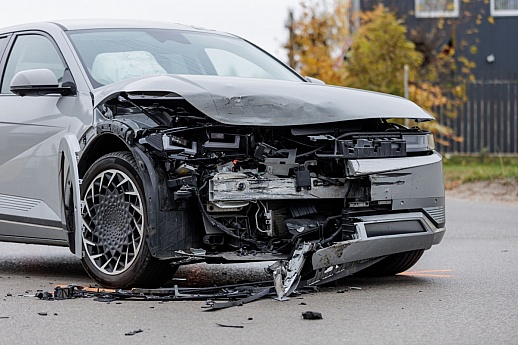How to Switch Car Insurance: A Step-by-Step Guide
Sometimes, it feels like we're on autopilot, especially with things like car insurance. We set it up once and then forget about it, letting the renewals roll over year after year. However, life's changes – like moving to a new city, family dynamics shifting, or simply finding out your neighbor has a better deal – can lead to reevaluating your car insurance needs.

Switching car insurance is about more than finding a cheaper rate. It's about ensuring your coverage matches your current life situation, from adding a teen driver to adjusting to new state laws or seeking better customer service. This guide provides clear advice to help you make an informed decision about your car insurance, fitting it seamlessly into your life's evolving path.
Changing Gears: Your Step-by-Step Guide to Switching Car Insurance
Switching your car insurance is straightforward when you know the right steps to take. It's about making a smart move that aligns with your life's current chapter, whether it's finding a budget-friendly option, adapting to a new family dynamic, or simply seeking better service.
Step 1: Assess Your Current Insurance Needs
Take a moment to reflect on what you need from your car insurance. Are lower rates your priority, or are you adjusting to a new phase in life that demands different coverage? Maybe it's customer service that's driving your decision. Pinpointing your specific needs sets the stage for finding a policy that truly fits.
Step 2: Research and Compare Insurance Providers
Now, dive into some research. Look at different insurance companies and weigh what they offer. To refine your car insurance research further, consider these key factors:
- Examine Coverage Details: Look into each company's specific coverage offerings, like liability, collision, and comprehensive coverage. See if they have options that suit your particular needs.
- Check Customer Service Ratings: Utilize independent review sites to gauge how each company fares in customer service. Websites like J.D. Power or Consumer Reports offer comprehensive reviews and ratings of insurance companies, which can be useful in evaluating overall satisfaction and performance.
- Compare Pricing: Don't just look at the bottom line; compare what each price tier offers. Remember, the cheapest option may not provide the best coverage.
- Look for Discounts: Many companies offer discounts for various reasons, such as safe driving records, multiple vehicles, or policy bundling. Check what discounts are available and how they might apply to you.
- Assess Financial Stability: A company's financial strength indicates its ability to handle claims effectively. Resources like AM Best ratings can be helpful here.
- User Experience: Consider how easy it is to interact with the company. This includes their website interface, policy management, and the claims process.
When comparing providers, you can approach it in two ways:
- Side-by-Side Comparisons: Use online car insurance comparison websites to view multiple providers at once. This can give you a broad overview and help you quickly narrow your choices.
- Direct Research: Visit each insurer's website for detailed information. This is especially useful for understanding their policy nuances and customer service approach.
Step 3: Check for Potential Penalties or Savings
Look for savings or discounts your new provider might offer for making the switch, as it is a great way to save on car insurance. When looking for a new insurance provider, consider these common types of discounts that could apply:
- Safe Driver Discounts: Up to 10% to 20% off premiums for those with no accidents or traffic violations.
- Multi-Car Discounts: Savings of about 10% to 25% per vehicle when insuring multiple cars with the same insurer.
- Bundling Policies: Combine auto insurance with homeowners' or renters’ insurance for 5% to 15% savings, depending on policy type and insurer.
- New Car Discounts: Insure new or relatively new vehicles for discounts of approximately 10% to 15%.
- Telematics-Based Discounts: Use a driving behavior monitoring app or device for discounts ranging from 5% to 30%, based on driving performance.
Remember, the savings will depend on the insurer and your circumstances.
Step 4: Apply for the New Policy
Once you've made your choice, it's time to apply. Gather the necessary paperwork, like your insurance documents, driver's license, and vehicle registration. This preparation will help streamline the application process. For added convenience, many insurers let you apply online, and you can receive your new policy documents via email.
Step 5: Cancel Your Old Policy
Once you’ve signed up with a new provider, cancel your previous policy to avoid paying double. You can typically cancel car insurance at any time, but first, confirm that your new policy is active to avoid any coverage gaps.
Here’s how to cancel your old plan:
- Contact Your Current Insurer: Reach out to your insurer via phone, email, or through their website. Some companies might require a written notice of cancellation.
- Verify Policy Cancellation Date: Make sure the cancellation date aligns with the start date of your new policy. This ensures continuous coverage.
- Check for Cancellation Fees: While many insurers allow you to cancel without a penalty, some might charge a cancellation fee, especially if you're ending a policy mid-term.
- Request Written Confirmation: After you've requested cancellation, ask for a written confirmation for your records. This serves as proof that you ended the policy.
- Consider Overlapping Coverage: To play it safe, consider having your new policy start a day before your old policy ends, as the consequences of driving without insurance can be severe. Having a day's overlap between the two policies is often a good idea. Coordinate the transition carefully, and consider temporary car insurance if there's a short gap.
Step 6: Update Your Information
After switching car insurance, promptly inform any lienholders or leasing companies about your new coverage. Also, revise insurance details on related documents like roadside assistance memberships or parking permits. This keeps all your records consistent with your new policy.
Start your search for better car insurance coverage today. Submit a free online request, and you could save.
How to Switch Insurance to a New Car
Getting a new car is an exciting time and means taking a fresh look at your car insurance. Whether upgrading to a family SUV or getting a more fuel-efficient model for your daily commute, your insurance needs might change.

Here's how to ensure your car insurance keeps pace with your new purchase or lease:
- Review Your Current Policy: Start by understanding what your current policy covers. This includes whether you have a standard policy, high-risk insurance, or full coverage, which typically combines liability, comprehensive, and collision coverages. If you're leasing a car, check if gap insurance is required and what it might cost, as it covers the difference between your vehicle’s value and the lease amount in case of total loss. Consider how your current coverage aligns with your evolving needs, identifying potential gaps to ensure your new policy provides comprehensive protection.
- Contact Your Insurance Provider: Give your current insurer a call. Tell them about your new car and discuss how this change affects your policy. They can provide options for transferring your existing coverage to your new vehicle or changing the policy type for more coverage.
- Consider Your New Car's Specifics: Every car is unique, and factors like its make, model, age, and safety features can impact your insurance needs and costs. For instance, a brand-new car might benefit from full-coverage car insurance plans.
- Explore New Policy Options: If your current provider's options don't fit or if you're curious about what else is out there, it's time to shop around. Compare offerings from different insurers to see who offers the best deal for your new car's needs.
- Update or Switch Your Policy: Once you've found the right fit, update your existing policy or switch to a new one. Ensure this is in place before driving your new car to stay covered.
- Inform Relevant Parties: If you're financing or leasing your new car, inform the lender or leasing company about your insurance coverage.
Expert Tip: Typically, drivers have about 30 days to switch their insurance from their old vehicle to a new vehicle.
Looking to switch policies because you got a new car? Explore new car insurance rates today.
How to Switch Car Insurance to Another State
Moving to a new state is a big step, and it brings changes to your car insurance needs. Each state has its own insurance laws and requirements, so you should have a policy that meets these new standards.
Here's a straightforward approach to ensure your car insurance is up-to-date when you make your move:
- Understand the New State's Insurance Requirements: Start by looking up the car insurance laws in your new state. This information is often available on the state's Department of Motor Vehicles (DMV) website. Look for minimum coverage requirements and any other specific regulations.
- Research Insurance Providers in Your New State: Not all insurance companies operate in every state. Visit the website of that state's Department of Insurance to check which insurers are available in your new location and what they offer.
- Compare Coverage and Prices: Once you know your options, compare them. Focus on finding coverage that meets the state's requirements and your needs. Look for the best balance of coverage and cost.
- Contact Your Current Insurer: Reach out to your current insurance provider to discuss your move. They might be able to transfer your policy to your new state or suggest alternatives if they don't operate there.
- Set Up Your New Policy Before Moving: Aim to have your new insurance policy start as soon as you arrive in your new state. This ensures continuous coverage and compliance with local laws.
- Update Your Registration and License: Remember to update your car's registration and driver's license to reflect your new address after the move. Your new state's DMV can guide you on how to do this.
Expert Tip: Do not cancel your current auto insurance before moving and getting a new policy. Driving across state lines without auto insurance is illegal and could affect your finances if you're involved in an accident.
How to Switch Auto Insurance Plans
Life is full of changes, and sometimes, these changes mean your car insurance needs to adapt, too. Maybe your family is growing, or perhaps your commute has changed. Whatever the reason, adjusting your insurance plan can help ensure you have the right coverage. Here’s how to do it:
- Review Your Current Coverage: Take a close look at your current insurance plan. What does it cover, and what are its limits? Understanding what you currently have is the first step in knowing what needs to change.
- Identify Your New Insurance Needs: Think about what's different now. Do you need more coverage because of a new car? Or maybe you need to add another driver to your policy. Understanding the types of car insurance available can help you make these decisions. List down these new requirements to guide your search for a new plan.
- Research Different Coverage Options: Now that you know what you need, explore what’s available. There might be new types of coverage that weren’t on your radar before. This is also a good time to see if some better deals or discounts fit your current situation.
- Talk to Insurance Agents: If unsure which option is best, speak with insurance agents. They can provide personalized advice based on your specific situation. They can guide you through the options, whether it’s sticking with your current provider or switching to a new one.
- Make the Switch or Update Your Plan: Once you’ve decided, either update your existing policy or switch to a new plan that better suits your needs. Ensure all your new information is accurately reflected in your policy.
- Review Your New Policy: After making changes, carefully review your new policy. This is to make sure everything is as you discussed and all your new needs are covered.
Expert Tip: Shop around for car insurance every six months to ensure you get the best possible deal. Be sure to get quotes from several companies to compare their offers.
Switching Car Insurance Companies
Deciding to switch car insurance companies is a significant step. It's about finding a provider that offers a better deal and aligns with your current needs and expectations. Here's a practical guide to making this switch effectively:
- Understand Why You're Switching: Are you seeking better rates, improved customer service, or more comprehensive coverage? Knowing your reasons will help you find a company that meets these expectations.
- Research and Compare New Companies: Take some time to explore different insurance companies. Look at their coverage options, customer service ratings, and pricing. This will help you find a company that offers what you're looking for at a reasonable price.
- Review the New Policy's Terms: Before making the switch, thoroughly understand the terms of your new policy. Pay attention to coverage limits, deductibles, and any exclusions. This ensures you know exactly what you're getting.
- Ensure Continuous Coverage: Plan the transition so there's no gap between when your old policy ends and your new one begins. This might mean overlapping the policies for a day or two for uninterrupted coverage.
- Notify Your Old Company: Once you're ready to switch, inform your current insurance company. They'll guide you through their cancellation process.
- Update Your Information: After switching, update your insurance information where necessary. This includes your vehicle registration and, if applicable, your lienholder or leasing company.
Expert Tip: Regularly switching insurance providers can lead to waiting periods for new coverage to commence, potentially higher premiums, and risks during the transition. Balance the desire for better rates with the stability offered by staying with one provider for a reasonable duration.
Are you looking for a provider with better coverage, rates, or customer service? Submit a request and check coverage options from reputable providers.
Switching Car Insurance After an Accident
An accident can be a turning point in your driving history, often affecting your car insurance rates. After an accident, consider switching your car insurance to find a more favorable rate.

Here's how to navigate this:
- Review the Impact on Your Current Rates: First, understand how the accident affects your current insurance rates. Some insurers might raise your premiums significantly, while others might have more lenient policies for first-time incidents.
- Gather Details About the Accident: When shopping for new insurance, you'll need to provide details about the accident. This includes the date, any claims you made, and the accident's impact on your driving record.
- Research Other Insurance Companies: Look into different insurers and how they handle customers with recent accidents, especially if you're looking for high-risk car insurance. Some companies specialize in high-risk drivers or offer accident forgiveness policies.
- Compare Quotes and Policies: Request quotes from various insurers and compare them. Pay close attention to how much coverage they offer and at what cost, especially in light of your recent accident.
- Check for Special Programs or Discounts: Some insurers might offer programs for drivers with accidents on their records. These could include defensive driving courses that, upon completion, might help reduce your rates.
- Make an Informed Decision: Consider your recent accident and choose an insurance company that offers a balance of reasonable rates and adequate coverage. Remember, the cheapest option isn’t always the best if it doesn’t provide the necessary coverage.
- Complete the Switch: Once you decide on a new insurer, follow the steps to switch your policy, ensuring no lapse in coverage.
Expert Tip: If you have an open claim, continue dealing with your current insurer for its resolution. Switching during an open claim means working with your old and new insurers simultaneously.
How Often Can You Switch Car Insurance
Switching car insurance is a flexible process; technically, you can do it as often as needed. However, it's smart to approach each potential switch with a thoughtful mindset. Here's what to consider:
- Understand Flexibility: While there's no set limit on how often you can change your car insurance, it's good to know that the option is always there. Life changes and your insurance can change with it.
- Consider the Timing of Switches: Frequent switches can be a red flag to insurers. They might see it as a sign of instability or high risk. So, it’s beneficial to have solid reasons for each change.
- Evaluate Your Reasons: Are you switching for a better rate, improved coverage, or better customer service? Make sure your reason for switching aligns with your long-term insurance needs.
- Look at the Long-Term Impact: Some insurance benefits, like loyalty discounts or accident forgiveness, build up with the same company over time. Weigh these long-term benefits against the short-term gains of switching.
- Check for Fees or Penalties: Some companies might charge for early cancellation. Always check for any potential fees before making a switch.
- Make Informed Choices: Research, compare, and then decide. If a switch makes sense for your current situation and offers better value, it’s a good move.
Bottom Line
Switching car insurance, whether due to life changes, seeking better rates, or desiring improved service, is a journey that requires careful consideration but can lead to significant benefits. Remember, your car insurance should be as dynamic as your life.
By staying informed and proactive about your insurance choices, you can ensure that your coverage meets legal requirements and provides the peace of mind and protection you and your family need. The world of car insurance offers many options, and with the right approach, you can find a policy that fits like a glove, adapting and growing with you at every turn.
FAQ
Navigating car insurance can raise many questions, especially when considering switching providers or policies. Here are answers to some frequently asked questions, helping you make informed decisions about your car insurance:
Can You Switch Car Insurance at Any Time?
Yes, you can switch your car insurance whenever you need to. However, it's good to be aware of any potential cancellation fees from your current provider. Also, make sure there's no gap in coverage during the transition.
Do You Get a Refund If You Switch Insurance?
If you've paid your insurance premium upfront, you're generally entitled to a refund when you won't use their services. This refund is often the unused portion of your premium minus any cancellation fees that may apply.
Can You Switch Insurance Plans Mid-Year?
Certainly, you can switch your insurance plans at any point in the year, including mid-year. This flexibility allows you to adapt your coverage as your life changes without waiting for the policy renewal date.
Can You Switch Insurance Companies in the Middle of a Claim?
You can switch insurance companies even if you have an ongoing claim. However, consider delaying your switch if you have an open claim for an accident. Changing providers immediately after an incident can lead to higher rates than waiting until the end of your policy's term.
How Long Does It Take to Switch Car Insurance?
Switching car insurance is typically a quick process. The actual time can vary depending on the specifics of your situation, but in many cases, the change can take effect almost immediately.
Sources
- AM Best. "Homepage." Accessed Dec. 6, 2023.
- Move.org. "How to Update Your License and Registration When You Move." Accessed Dec. 6, 2023.
- CNBC. "Here's how often you should shop for car insurance to get the best price on coverage." Accessed Dec. 6, 2023.
- Policygenuis. "Can I switch car insurance with an open claim?" Accessed Dec. 6, 2023.



